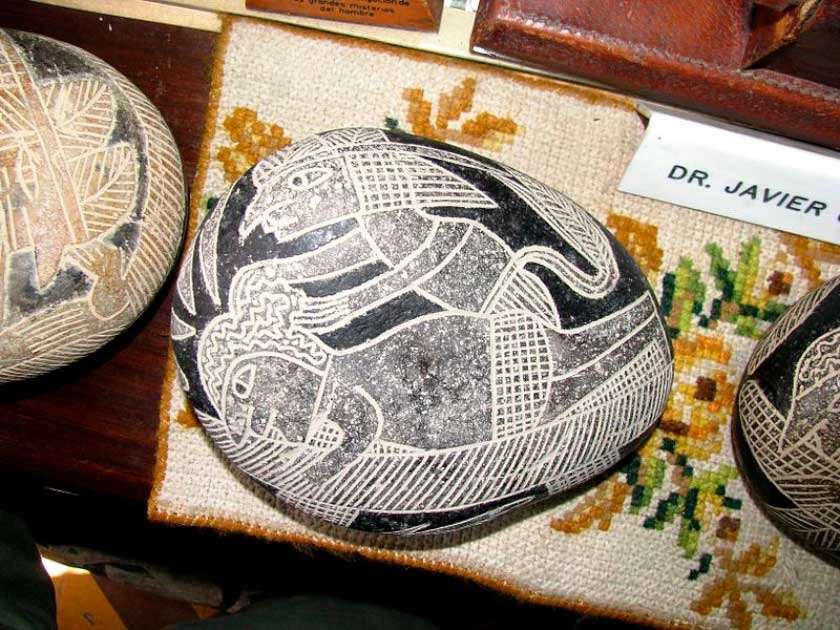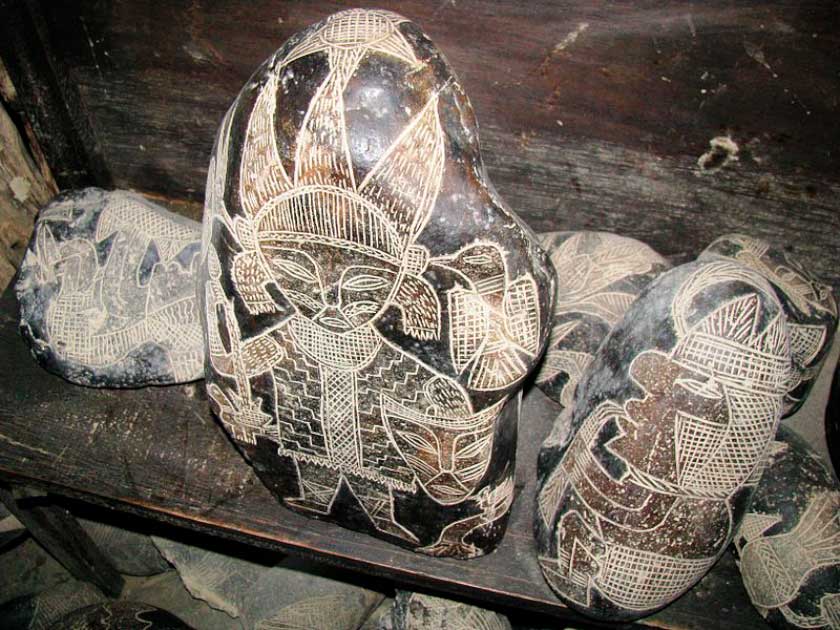From time to time a scientific or archaeological discovery is made that re-writes how we see the world and shows us that what we believed we knew was wrong. Sometimes, however, these discoveries are so outlandish, so bizarre that they just can’t be verified. In other words, they are hoaxes.
The Ica stones are a series of more than 10,000 stones first “found” in the Ica Province of Peru. Supposedly dating back thousands of years they show scenes of advanced technology from lost civilizations, strange maps, and even dinosaurs mixing with humans. It would be easy to write them all off as hoaxes but the question is, can any of them be trusted?
What are the Ica Stones?
The Ica stones are a group of over 10,000 andesite stones that were supposedly found in the Ica province of Peru. The stones vary in size with the smallest being less than an inch in diameter and length and the largest being up to 40 cm (16 inches) in length. The stones appear to be heavily weathered and have developed a thin patina (discoloration/ pattern).
Most of these stones reside in the collection of a Peruvian physician called Javier Cabrera. They were first discovered, however, by a local farmer by the name of Basilo Uschuya. Basilo approached Cabrera claiming he had originally approached archaeological authorities but had been ignored.
Cabrera was fascinated by the stones and became their biggest promoter, founding a small private Museum in their honor in 1966. Starting with just a few stones, over the years Basilo brought his benefactor hundreds of them.
For decades they have fascinated everyone from young earth creationists to believers in Ancient Astronauts and mytho-historians: “historians” who believe ancient myths and legends aren’t myths but are historically accurate. The Ica stones have proven to be something of a puzzle.
What do the Ica Stones Depict?
The stones fall into two groups, the realistic and the fantastical. The tamer, more realistic stones feature shallow engravings and reliefs that are deemed historically accurate.

Some have simple, rudimentary depictions of local flowers, fish, and living animals. Others feature extremely complex designs that can be traced back to the Paracas, Nazca, Tiwanaku, and Inca cultures.
- Mokele-Mbembe: A Dinosaur Hidden in the Jungles of Africa?
- Beringer’s Lying Stones: How did a Professor find Fossils of God?
Then there’s the second group. These feature depictions that do not mesh, at all, with established history. The subjects vary greatly but include maps the Inca people shouldn’t have had access to, depictions of massively advanced ancient civilizations, dinosaurs coexisting with humans, and depictions of advanced surgical methods.
The stones were a conspiracy theorist’s dream discovery. Young Earth creationists (who typically put the earth at 6,000-10,000 years old and take the book of Genesis literally) have used the stones to “disprove” the idea that humans and dinosaurs lived millions of years apart.
On the other hand, believers in ancient astronauts have used the stones to prove that Earth was once home to an advanced civilization that had come from the stars. Even mytho-historians have joined the party, claiming the stones show that the monsters of ancient mythology once roamed the earth.
Real or Hoax?
It would be easy (and fun) to write off all the stones as a hoax but this would be doing them a disservice. There is evidence that some of the stones could be legitimate. It’s easy to guess which ones.
We have archaeological evidence of Peruvian cultures that goes back thousands of years. Many excavations were carried out in the Ica province during the late nineteenth and early twentieth centuries but none of them reported carved andesite amongst their findings.
Yet at the same time carved stones, reportedly looted by grave robbers known as huaqueros constantly appeared for sale, aimed at tourists and amateur collectors. Were they fake?
Well, one of these amateur collectors also happened to be Santiago Agurto Calvo, a professional archaeologist and the Rector of the National University of Engineering in Lima. Looking for an answer he organized several searches and in 1966 found a carved andesite stone in the Callango district of Ica Valley.
Its carvings matched those of the Tiwanaku culture. He was later joined by another respected archaeologist, Alejandro Pezzia Assereto, curator of the Regional museum in Ica City.
The two men went on to find Ica stones that matched the Paracas culture as well as two more deemed to be from the Middle Horizon Period (600-1000 AD). All the stones discovered by the two men fall into our “realistic” category.
They either featured designs associated with Ica cultures or depictions of local animal and plant life. There is little reason to think the two men faked their findings.
On the other hand, the stones discovered by Mr. Uschuya the farmer are most definitely fake. How do we know this? Well for a start, Mr. Uschyuya said so, repeatedly. During the late 1960s and early 70s, the Ica stones received quite a lot of international attention.
This attention culminated in a BBC special in 1973 that was, to put it nicely, scathing. In response, rather than even attempting to defend himself the farmer admitted to carving the stones himself and then artificially aging them to give them their distinct patina. He and a friend claimed the stones they had sold to Cabrera had been copied from comics, textbooks, and magazines.

Over the next few years, Uschuya repeatedly took back and remade his confession, in an attempt to avoid jail. As it turned out he was trapped between an andesite rock and a hard place. He was either going to jail for selling archaeological evidence or going to jail for fraud.
Of course, ardent conspiracy theorists will just claim Uschuya and his friend were forced to make their confession. So what other evidence do we have that the stones were faked, besides Uschuya on tape showing how he faked the stones?
Well, we have no other archaeological evidence that a mysterious, hyper-advanced civilization ever existed. It is beyond implausible that the only trace such a civilization would leave is a few stones in Ica. One just has to look at the impact our civilization has made on the natural world in the last hundred years to show how bizarre this claim is.
We also have no reliable way, besides the handful of stones discovered by archaeologists, to date the stones “discovered” by Uschuya. We do, however, through radiometric dating(which measures radioactive decay in elements like carbon) have an abundance of evidence that shows dinosaurs died out millions of years before our earliest ancestors walked the earth.
Fake Conclusions
Unless someone is a dedicated conspiracy theorist, determined to ignore mountains of evidence, it is clear that the Ica stones found by Mr. Uschuya were faked. The forgeries have become somewhat of a cottage industry, to this day the stones are still being manufactured, forgeries of the original forgeries.
Today most of us would agree that the stones are just an interesting and amusing hoax. The strangest part is how a couple of friends managed to make so many stones and how they managed to captivate the imaginations of so many people. To this day there are still groups attempting to prove the stones’ legitimacy, their devotion to a decades-old hoax is truly astonishing.
Top Image: The Ica Stones appear to depict humans and dinosaurs co-existing. Source: Brattarb / CC BY-SA 3.0.